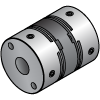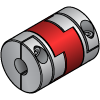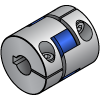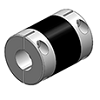(!)NOTE : Windows 7 users won’t be able to use some latest features of eCatalog/WOS since Microsoft is ending support for Windows 7 on 14 Jan, 2020. Please upgrade your system for uninterrupted services.
- Notice of End of Sales for Economy Series Pneumatic Equipment Category. More information.
MIKI PULLEY Flexible Shaft Couplings(Type:Vibration Damping Rubber Type)
|
Type
|
|
|---|---|
Brand |
|
| CAD |
|
| Days to Ship |
|
1 items
- Sort By
-
You can add up to 6 items per a category to the compare list.

MIKI PULLEY
Newly developed multi-layer rubber element achieves high attenuation and low recoil force. Couplings with high damping performance. For servo and stepper motors.
Integrated structure with no backlash that adopts HNBR for the power transmitting element. Damps vibration more quickly than a flexible coupling using metal for the elastic part.
This makes it possible to inhibit resonance, a phenomenon which tends to occur with stepper motors, etc. Helps avoid resonance over a wide range of operating speeds. Provides stable high speed control.
Furthermore, by using a layered rubber element sandwiched between HNBR with different levels of hardness, the shaft reaction force due to misalignment is reduced. The burden on the counter shaft and bearing can be reduced drastically.Type Shaft Bore Dia. (machined) D1(Ø) Shaft Bore Dia. (machined) D2(Ø) Outer Dia. A(Ø) Overall Length W(mm) Application Allowable Torque Range(N•m) Features Allowable Misalignment Max. Rotational Speed Range(r/min) Body Material Allowable Torque(N•m) Allowable Angular Misalignment(deg) Allowable Lateral Misalignment(mm) Product Category Allowable Lateral Misalignment Range(mm) Max. Rotational Speed(r/min) Buffer Material Disc Material Bellows Material Cleaning Method Characteristics/Applications Environmentally friendly Vibration Damping Rubber Type 3 ~ 28 3 ~ 30 13 ~ 56 18 ~ 60 Servo Motor / Stepping Motor 0.05~1.00 ~ 50.01~100.00 High Torque ~ Vibration Insulation Angular Misalignment / Eccentricity / Axial Misalignment 4001~10000 Aluminum 1 ~ 60 1.5 0.15 ~ 0.2 Coupling Main Body 0.02~0.2 10000 Others - - - - - From: ₹ 4,090.07 Days to Ship: 6 Day(s) or more  6 Day(s) or more
6 Day(s) or more
| Brand |
|---|
| Product Series |
| From |
| Days to Ship |
| Type |
| Shaft Bore Dia. (machined) D1(Ø) |
| Shaft Bore Dia. (machined) D2(Ø) |
| Outer Dia. A(Ø) |
| Overall Length W(mm) |
| Application |
| Allowable Torque Range(N•m) |
| Features |
| Allowable Misalignment |
| Max. Rotational Speed Range(r/min) |
| Body Material |
| Allowable Torque(N•m) |
| Allowable Angular Misalignment(deg) |
| Allowable Lateral Misalignment(mm) |
| Product Category |
| Allowable Lateral Misalignment Range(mm) |
| Max. Rotational Speed(r/min) |
| Buffer Material |
| Disc Material |
| Bellows Material |
| Cleaning Method |
| Characteristics/Applications |
| Environmentally friendly |
You can add up to 6 items per a category to the compare list. | |
| Brand | MIKI PULLEY |
| Product Series | |
| From | ₹ 4,090.07- |
| Days to Ship | 6 Day(s) or more |
| Type | Vibration Damping Rubber Type |
| Shaft Bore Dia. (machined) D1(Ø) | 3 ~ 28 |
| Shaft Bore Dia. (machined) D2(Ø) | 3 ~ 30 |
| Outer Dia. A(Ø) | 13 ~ 56 |
| Overall Length W(mm) | 18 ~ 60 |
| Application | Servo Motor / Stepping Motor |
| Allowable Torque Range(N•m) | 0.05~1.00 ~ 50.01~100.00 |
| Features | High Torque ~ Vibration Insulation |
| Allowable Misalignment | Angular Misalignment / Eccentricity / Axial Misalignment |
| Max. Rotational Speed Range(r/min) | 4001~10000 |
| Body Material | Aluminum |
| Allowable Torque(N•m) | 1 ~ 60 |
| Allowable Angular Misalignment(deg) | 1.5 |
| Allowable Lateral Misalignment(mm) | 0.15 ~ 0.2 |
| Product Category | Coupling Main Body |
| Allowable Lateral Misalignment Range(mm) | 0.02~0.2 |
| Max. Rotational Speed(r/min) | 10000 |
| Buffer Material | Others |
| Disc Material | - |
| Bellows Material | - |
| Cleaning Method | - |
| Characteristics/Applications | - |
| Environmentally friendly | - |
Loading...
Configure
Specification/Dimensions
-
Shaft Bore Dia. (machined) D1(Ø)
-
Shaft Bore Dia. (machined) D2(Ø)
-
Outer Dia. A(Ø)
- 6
- 6.4
- 8
- 9
- 9.5
- 10
- 12
- 12.7
- 13
- 13.5
- 14
- 14.5
- 15
- 16
- 16.1
- 16.5
- 16.6
- 16.8
- 17
- 17.5
- 18
- 19
- 19.1
- 20
- 21
- 22
- 22.2
- 24
- 24.5
- 25
- 25.4
- 25.5
- 26
- 26.2
- 26.6
- 27
- 27.3
- 28
- 29
- 30
- 31.7
- 31.8
- 32
- 33
- 33.3
- 34
- 34.4
- 35
- 36
- 38
- 39
- 39.5
- 40
- 41.3
- 42
- 42.5
- 43
- 44
- 44.5
- 45
- 46
- 47
- 48
- 49
- 50
- 53
- 53.6
- 54
- 54.5
- 55
- 56
- 57
- 58
- 60
- 63
- 64
- 65
- 66
- 68
- 69
- 69.9
- 70
- 73
- 75
- 79
- 79.5
- 80
- 81
- 82
- 83
- 85
- 87
- 88
- 90
- 93
- 94
- 94.5
- 95
- 99
- 100
- 102
- 104
- 104.5
- 105
- 112
- 117
- 118
- 120
- 125
- 126
- 138
- 140
- 143
- 144
- 150
- 152
- 155
- 160
- 161
- 168
- 170
- 178
- 185
- 190
- 194
- 200
- 210
- 214
- 225
- 246
- 262
- 276
- 308
- 346
-
Overall Length W(mm)
- 5.1
- 7.3
- 8.4
- 9
- 9.4
- 9.6
- 10
- 10.2
- 10.5
- 11.2
- 11.4
- 11.8
- 11.9
- 12
- 12.35
- 12.4
- 12.7
- 13
- 13.5
- 14
- 14.2
- 14.4
- 14.5
- 14.6
- 14.7
- 14.9
- 15
- 15.5
- 15.6
- 15.7
- 15.8
- 15.9
- 16
- 16.2
- 16.5
- 16.6
- 16.7
- 17
- 17.4
- 17.5
- 17.6
- 17.8
- 18
- 18.1
- 18.4
- 18.5
- 18.7
- 18.8
- 19
- 19.1
- 19.2
- 19.35
- 19.4
- 19.6
- 19.7
- 19.8
- 20
- 20.2
- 20.4
- 20.5
- 21
- 21.2
- 21.3
- 21.4
- 21.5
- 21.6
- 22
- 22.1
- 22.2
- 22.5
- 23
- 23.05
- 23.1
- 23.15
- 23.2
- 23.3
- 23.4
- 23.5
- 23.6
- 24
- 24.1
- 24.2
- 24.4
- 24.5
- 24.9
- 25
- 25.4
- 25.5
- 25.6
- 25.7
- 25.9
- 26
- 26.2
- 26.5
- 26.6
- 27
- 27.2
- 27.3
- 27.4
- 28
- 28.2
- 28.3
- 28.4
- 28.5
- 28.8
- 29
- 29.5
- 29.8
- 30
- 30.2
- 30.4
- 30.5
- 31
- 31.2
- 31.4
- 31.5
- 31.6
- 31.7
- 32
- 32.2
- 32.3
- 32.5
- 32.6
- 32.7
- 32.8
- 33
- 33.3
- 33.5
- 33.8
- 34
- 34.3
- 34.4
- 34.5
- 35
- 35.6
- 36
- 36.1
- 36.5
- 36.8
- 37
- 37.2
- 37.4
- 37.8
- 38
- 38.2
- 38.5
- 38.6
- 39
- 39.2
- 39.4
- 39.5
- 39.7
- 40
- 40.5
- 41
- 41.8
- 42
- 42.2
- 43
- 43.2
- 43.4
- 43.5
- 43.6
- 44
- 44.2
- 44.5
- 44.7
- 44.8
- 45
- 45.2
- 45.5
- 46
- 46.6
- 47
- 47.6
- 48
- 48.4
- 49.2
- 49.4
- 50
- 50.2
- 50.6
- 50.8
- 51
- 51.2
- 51.3
- 52
- 52.8
- 53
- 53.4
- 53.6
- 54
- 54.1
- 54.4
- 54.5
- 54.6
- 55
- 55.5
- 56
- 56.2
- 56.5
- 56.6
- 57
- 58
- 58.2
- 58.5
- 58.6
- 59
- 59.7
- 59.8
- 59.9
- 60
- 60.4
- 60.5
- 61
- 61.2
- 62
- 63
- 63.4
- 63.5
- 63.6
- 63.7
- 63.8
- 64
- 64.8
- 65
- 65.6
- 66
- 66.6
- 66.8
- 67
- 67.1
- 67.5
- 68
- 68.3
- 68.5
- 68.6
- 68.7
- 68.8
- 69.5
- 69.6
- 69.8
- 70
- 70.5
- 70.6
- 71
- 71.2
- 72
- 72.4
- 73
- 73.3
- 74
- 74.4
- 74.8
- 75
- 75.6
- 76.2
- 77
- 77.6
- 77.8
- 78
- 78.8
- 79.5
- 79.8
- 80
- 80.8
- 81
- 82
- 82.5
- 82.6
- 83
- 83.6
- 84
- 84.7
- 85
- 85.2
- 85.5
- 85.6
- 86
- 88
- 89.3
- 89.5
- 89.6
- 89.8
- 89.9
- 90
- 90.5
- 90.8
- 91
- 92
- 93.6
- 94
- 95
- 95.6
- 96
- 97
- 97.2
- 98
- 98.5
- 98.6
- 99
- 99.2
- 99.6
- 100
- 100.2
- 101
- 101.6
- 102
- 102.5
- 104
- 104.4
- 105.8
- 106
- 107.6
- 108
- 109
- 110
- 112.8
- 113
- 114
- 115
- 115.6
- 117.6
- 118.4
- 118.8
- 119.6
- 120
- 120.8
- 121
- 123.6
- 124
- 125
- 126
- 127
- 129
- 129.6
- 130
- 131
- 136.4
- 137.6
- 138
- 140
- 141
- 144
- 144.2
- 146
- 147
- 150
- 150.6
- 153.0
- 154
- 154.6
- 156.4
- 160
- 164
- 164.6
- 170.6
- 176
- 178.4
- 182.8
- 192.4
- 193
- 200
- 208.8
- 209.2
- 216
- 217
- 218
- 223
- 238
- 241.2
- 249.4
- 260
- 286.8
- 290
- 307.0
- 335
- 337.2
- 377
- 391
- 421
- 607
-
Application
- Standard
- Servo Motor
- Stepping Motor
- Encoder
-
Allowable Torque Range(N•m)
-
Features
-
Allowable Misalignment
-
 Not Provided
Not Provided -
 Angular Misalignment
Angular Misalignment -
 Eccentricity
Eccentricity -
 Axial Misalignment
Axial Misalignment
-
-
Max. Rotational Speed Range(r/min)
-
Body Material
- Stainless Steel
- Steel
- Aluminum
- Alloy
- Plastic
- Aluminum Alloy
-
Allowable Torque(N•m)
-
Allowable Angular Misalignment(deg)
-
Allowable Lateral Misalignment(mm)
-
Product Category
- Coupling Main Body
- Maintenance Components
-
Allowable Lateral Misalignment Range(mm)
-
Max. Rotational Speed(r/min)
-
Buffer Material
-
Disc Material
-
Bellows Material
-
Cleaning Method
- Degreasing
- Precision Cleaning
-
Characteristics/Applications
-
Environmentally friendly
- RoHS Compliant (10 Substances)
Narrow search by specifying Manufacturer
-
- MISUMI (0)
- NABEYA BI-TECH (2)
- MIKI PULLEY (1)
- ORIENTAL MOTOR (0)
- KOYO ELECTRONIC (0)
- ADVANCED (0)
- ISEL (0)
- MITSUBOSHI BELTING (0)
- NIHON MINIATURE (0)
- KAYSEVEN (0)
- SUNGIL (0)
- MIGHTY (0)
- SAKAI MANUFACTURING (0)
Related Categories to Flexible Shaft Couplings
FAQ Flexible Shaft Couplings
- Question: What are the different types of flexible Shaft Couplings?
- Answer: There are several types of flexible Shaft Couplings, including beam, bellows, jaw, Oldham, disc, diaphragm, and gear couplings. Each type has unique features and benefits that make them suitable for different applications and environments. Flexible Shaft Couplings are used to connect two shafts and allow for misalignment while transmitting torque between them.
- Question: What factors should be considered when selecting a flexible Shaft Couplings?
- Answer: The factor for selecting a flexible coupling, there are several factors that should be considered, including the required torque capacity, misalignment capability, operating speed, and environmental factors such as temperature and humidity. Other considerations include the required degree of axial and radial stiffness, the space available for the coupling, and the type of equipment being connected. It is also important to consider the potential for wear and tear, maintenance requirements, and the cost of the coupling.
- Question: How is a flexible Shaft Couplings installed and maintained?
- Answer: Shaft Couplings are installed by aligning the shafts and tightening the screws or bolts. Maintenance involves regular inspections for signs of wear, damage, or misalignment. Lubrication is important to prevent excessive wear and reduce friction. Cleaning and tightening of bolts and screws are also necessary to ensure proper operation.
- Question: What is the difference between a flexible coupling and a rigid coupling?
- Answer: A flexible coupling allows for some misalignment between two connected shafts while transmitting torque, while a rigid coupling does not allow for any misalignment. Flexible Shaft Couplings are designed to absorb shock and vibration, which can help reduce wear and tear on connected equipment. Rigid couplings, on the other hand, are used in applications where precise alignment between shafts is critical, such as in high-speed rotating equipment or precision machinery.
















How can we improve?
How can we improve?
Thank you for your time.
Your feedback is essential for our continuous improvement
Privacy Policy
Thank you for your cooperation.
Thank you for your time.
Your feedback is essential for our continuous improvement
Please use the inquiry form.
Privacy Policy